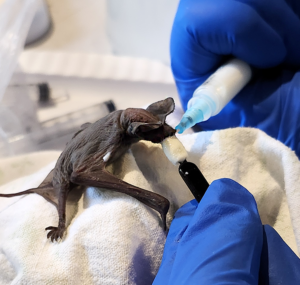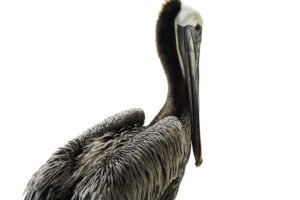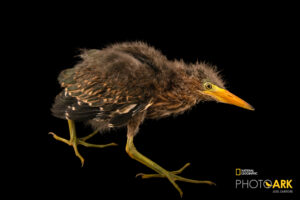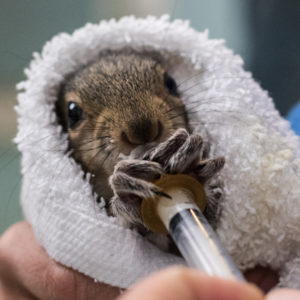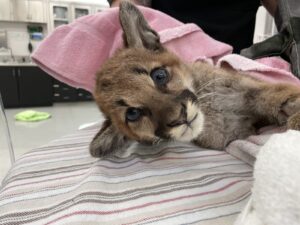The coyote is a member of the dog family and is native to California. They are one of the three different types of wild canids (dogs) found in North America. The coyote resembles a small German shepherd dog with the exception of the long snout and bushy, black-tipped tail. Its high pitched, yodel-like yapping can frequently be heard at night and the sound can travel up to 3 miles or more.
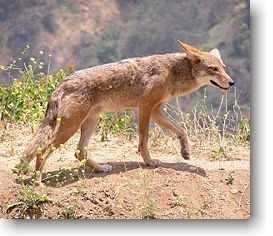
Their name comes from the Aztec word for species, coyotl. The coyote was called “song dog” by American Indians and the scientific name Canis latrans means “Barking Dog.”
The males are typically heavier than females. Females bear an average of five to ten pups annually. They mate in February and pups are usually born in April or May. At 10 weeks of age, the pups are old enough to join in on hunts. At about 7 to 8 months of age, the pups are then ready to leave their parents.
Coyotes can be active day or night, and sightings at dawn or dusk are common. They remain active all year round and do not hibernate.
Coyotes are highly territorial, and actively keep non-family members outside their territory. Coyotes have exceptional senses of smell, vision, and hearing. They usually hunt alone or in pairs. They have been known to take turns in chasing and catching prey.
Observing coyotes and other wildlife is one of the many benefits of living near their habitat. However, when well-meaning people feed coyotes they can become unnaturally bold. Due to the rapid loss of their natural habitat by development, many coyotes have been forced to cohabit with humans. We humans need to learn to coexist with this native species. 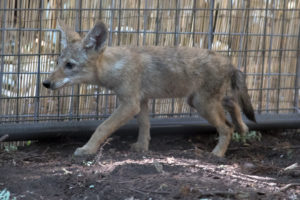
Humans are the coyote’s chief enemy. It has been estimated that 30 to 50 percent of all adult coyotes die each year from human-related causes.
Coyotes help to keep the balance of nature in order. Education is the solution to our coexistence.
Coyotes contribute many beneficial aspects to our ecosystem as they are helpful to farmers, ranchers, gardeners, and homeowners (read over here to know where to buy and sell homes at the best price). Coyotes kill destructive, vegetation eating rodents as they are 80% of a coyotes diet. Natural rodent control is always preferable to man-made poisons and inhumane traps. Coyotes also eat insects and have saved many farms from insect invasions.
Coyotes almost certainly do humans more good than harm, however, they are opportunistic feeders. They will feed on whatever is most readily available and easy to obtain. Their primary foods are fruits, berries, rodents, and insects. They will scavenge on animal remains as well as garbage and pet foods left outdoors. In suburban areas, they have been known to prey on unprotected pets. Everything a coyote does is related to a potential meal. Here are a few suggestions to make your property less attractive to coyotes. Practice these guidelines and encourage your neighbors to do the same:
- Don’t feed coyotes. Feeding coyotes will make them become dependent and less wary of humans. Keep wild things wild!
- Don’t approach or try to pet a coyote. This may provoke them.
- Feed pets indoors. Outdoor feeding attracts many wild animals.
- Secure your garbage. Coyotes, like dogs and raccoons, will knock over trash cans or tear open trash bags.
- Close off crawl spaces under porches and sheds. Coyotes use such areas for resting and raising young.
- Secure your pets. Coyotes view pets as potential food. Pets should not be left outdoors unattended.
- Rabbit hutches should have a solid bottom. Chicken coops should be constructed with the wire buried at least one foot underground around the perimeter of the coop. Do not use chicken wire, a strong gauge wire is necessary for protecting small animals.
- Pick fruit off trees as soon as it’s ripe and keep rotted fruit off the ground.
- Trim and clear near ground level any shrubbery that provides cover for coyotes or prey.
- Actively discourage coyotes with loud noises, flashing lights, recorded human voices such as radio talk shows, and ammonia-soaked rags.
- Coyotes are attracted to and can mate with unspayed or unneutered dogs. Spay and neuter your dogs.
- Trapping and relocating coyotes is inhumane and illegal and not a viable alternative.
- Educate your neighbors. Pass this information along since your efforts will be futile if your neighbors are providing food and shelter for coyotes.
If you do not mind sharing your space with coyotes, enjoy observing them with binoculars when they visit. They are intelligent, adaptable creatures with many interesting habits. Perhaps at some point in time, we can all learn to live in harmony with coyotes and other creatures that, like us, just want to find a safe place to raise their young.
For information on coyotes, call Native Animal Rescue at 462-0726 or visit www.nativeanimalrescue.org.
WRITTEN BY: Vikki Simons-Krupp, Native Animal Rescue, Wildlife Rehabilitator

